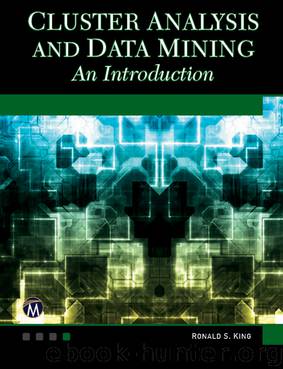Cluster Analysis and Data Mining: An Introduction by R.S. King

Author:R.S. King
Language: eng
Format: epub
Tags: Cluster Analysis and Data Mining: An Introduction
ISBN: 9781938549380
Publisher: Mercury Learning and Information
Published: 2014-10-12T16:00:00+00:00
Then P(x|buy_computer = No) = (3/7)(1/5)(4/5)(2/5) = 0.0274
P(x|buy_computer = Yes) = P(Age is x = 30|buy_computer = Yes) *
P(Income = Medium|buy_computer = Yes) *
P(Student = No|buy_computer = Yes) *
P(Credit_rating = Fair|buy_computer = Yes)
P(x|buy_computer = Yes) = (1/8)(3/8)(1/8)(4/8) = 0.0293
P(x|buy_computer = No) P(buy_computer = No) = (0.0274)(5/13) = 0.0105
P(x|buy_computer = Yes) P(buy_computer = Yes) = (0.0293)(8/13) = 0.018
Then P(buy_computer = No|x) ≤ P(buy_computer = Yes|x) implies that x is assigned to the class buy_computer = Yes.
Note that in this problem instance all the attributes were categorical. For each continuous attribute A in a data set for an NBC, simply implement a set of labels for the continuous values. Place one ordinal value per label. By assuming the data is normally distributed, which allows the use of the sample mean and standard deviation as estimates for the population mean and standard deviation, the P(the jth attribute value |C) can be found.
Download
This site does not store any files on its server. We only index and link to content provided by other sites. Please contact the content providers to delete copyright contents if any and email us, we'll remove relevant links or contents immediately.
Algorithms of the Intelligent Web by Haralambos Marmanis;Dmitry Babenko(8325)
Azure Data and AI Architect Handbook by Olivier Mertens & Breght Van Baelen(6943)
Building Statistical Models in Python by Huy Hoang Nguyen & Paul N Adams & Stuart J Miller(6930)
Serverless Machine Learning with Amazon Redshift ML by Debu Panda & Phil Bates & Bhanu Pittampally & Sumeet Joshi(6808)
Data Wrangling on AWS by Navnit Shukla | Sankar M | Sam Palani(6597)
Driving Data Quality with Data Contracts by Andrew Jones(6554)
Machine Learning Model Serving Patterns and Best Practices by Md Johirul Islam(6286)
Learning SQL by Alan Beaulieu(6021)
Weapons of Math Destruction by Cathy O'Neil(5813)
Big Data Analysis with Python by Ivan Marin(5474)
Data Engineering with dbt by Roberto Zagni(4473)
Solidity Programming Essentials by Ritesh Modi(4125)
Time Series Analysis with Python Cookbook by Tarek A. Atwan(3986)
Pandas Cookbook by Theodore Petrou(3695)
Blockchain Basics by Daniel Drescher(3321)
Hands-On Machine Learning for Algorithmic Trading by Stefan Jansen(2923)
Feature Store for Machine Learning by Jayanth Kumar M J(2831)
Learn T-SQL Querying by Pam Lahoud & Pedro Lopes(2815)
Mastering Python for Finance by Unknown(2757)
